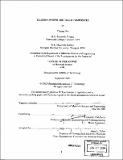Silicone resins and their composites
Author(s)
Wu, Yuhong, 1972-
DownloadFull printable version (26.95Mb)
Other Contributors
Massachusetts Institute of Technology. Dept. of Materials Science and Engineering.
Advisor
Frederick J. McGarry.
Terms of use
Metadata
Show full item recordAbstract
Addition cure (X1-2672) and condensation cure (4-3136) silicone resins have been studied for their mechanical property change with temperature. Properties include maximum flexural stress, flexural modulus and fracture toughness K[sub]IC. Temperature effect on mechanical properties of addition cure resin is substantial and also depends on the crosslinkers used. Generally the maximum stress and flexural modulus decrease with temperature, and the dependence upon crosslinkers in addition cure resin is obvious. Fracture toughness data of addition cure silicone resins have a peaking behavior with the peak appearing [approximately] 58-101CÌŠ (depending on the crosslinker) below their glass transition temperatures. This can be explained by the competing effect between network mobility and rigidity of the silicone polymer. Rate effect on fracture toughness of silylphenylene crosslinked 2672 has also been studied. It is concluded that the temperature effect on such a system is more dominant compared to the rate effect. The condensation resins also experience decrease in modulus and strength but the toughness changes little with temperature. This is due to its tight network structure. Silylphenylene crosslinked addition cure resin (2672B) and the toughened condensation cure resin (3136T) were used to make silicone fiberglass laminates. They have been successfully processed with a vacuum bagging technique. Silicone resin composites are proved to be thermally stable, moisture resistant and fire resistant. However, they have weak strength and modulus. Their temperature dependence of mechanical properties is also big and results in poor property retention at high temperatures. 2672B was used to produce hybrid composites with an organic resin-vinyl ester. The processes of curing the hybrid composites in both sequential cure and co-cure methods prove to be successful. The hybrid composites are stronger and their property retention at elevated temperatures is improved compared to silicone resin composites. They also have improved moisture resistance, thermal stability and fire resistance over vinyl ester composites. The co-cured V/B 8/4 structure has excellent strength and rigidity and also extraordinary property retention at high temperatures, which can be explained by the chemical reaction at the silicone resin and vinyl ester resin interface. The hybrid composites prove to be successful in having balanced mechanical and environmental properties.
Description
Thesis (Ph. D.)--Massachusetts Institute of Technology, Dept. of Materials Science and Engineering, 2003. Includes bibliographical references.
Date issued
2003Department
Massachusetts Institute of Technology. Department of Materials Science and EngineeringPublisher
Massachusetts Institute of Technology
Keywords
Materials Science and Engineering.